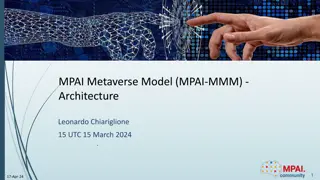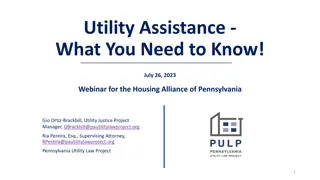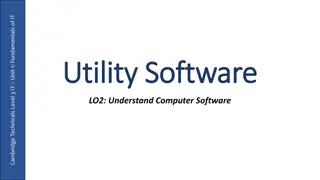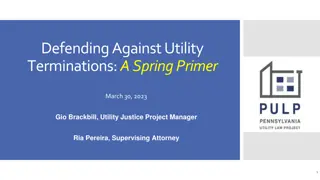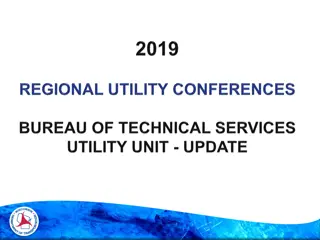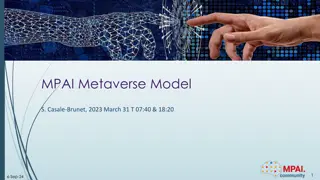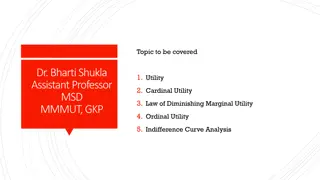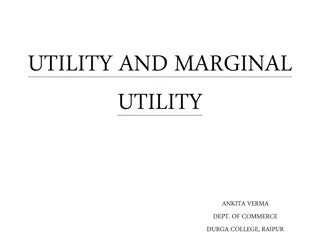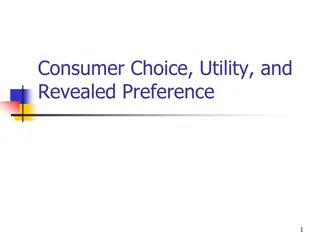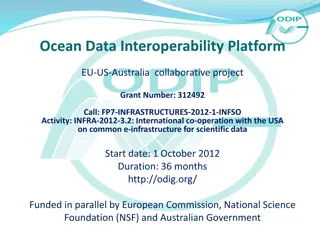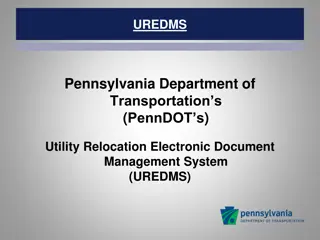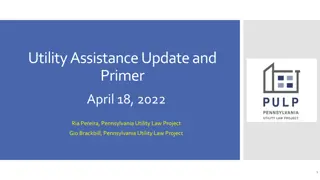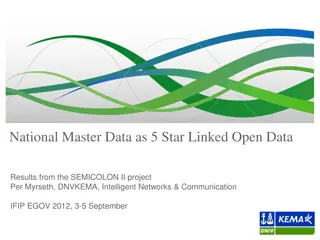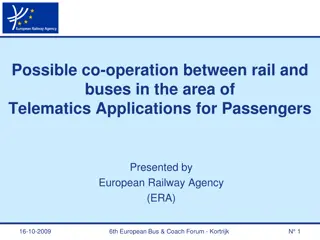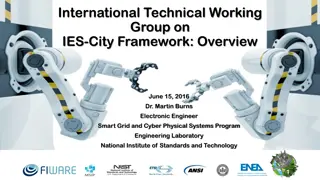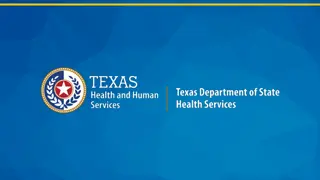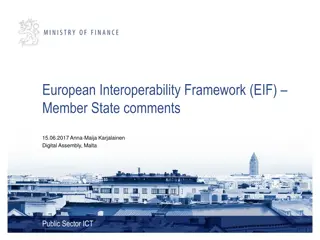OpenFMB Framework: Empowering Utility Interoperability
Open Field Message Bus (OpenFMB) is a framework and reference architecture designed to enable interoperability for Distributed Intelligence Applications, focusing on cybersecurity, microgrids, Distributed Energy Resources (DER), and more. It provides a standard API for Electric Grid interoperability, utilizing secure, peer-to-peer communication and common semantic models. By leveraging existing standards and IoT protocols, OpenFMB aims to facilitate field interoperability for utility deployments while prioritizing flexibility, scalability, security, and backward compatibility.
Download Presentation

Please find below an Image/Link to download the presentation.
The content on the website is provided AS IS for your information and personal use only. It may not be sold, licensed, or shared on other websites without obtaining consent from the author.If you encounter any issues during the download, it is possible that the publisher has removed the file from their server.
You are allowed to download the files provided on this website for personal or commercial use, subject to the condition that they are used lawfully. All files are the property of their respective owners.
The content on the website is provided AS IS for your information and personal use only. It may not be sold, licensed, or shared on other websites without obtaining consent from the author.
E N D
Presentation Transcript
NAESB OpenFMB Task Force OpenFMB Specification Development Plan M. Joe Zhou, Stuart Laval Co-Chairs, NAESB OpenFMB TF OpenFMB Task Force Update May 13th, 2015 May 13th, 2015 NAESB OpenFMB TF 1
What is Open Field Message Bus? Framework and reference architecture for Distributed Intelligence Apps and systems Cybersecurity, microgrids, DER, DA, AMI Blueprint for utility interoperability test beds Standard API for Electric Grid interoperability Secure, peer-to-peer, multi-vendor, outside data center Common Semantic models based on existing standards (CIM, IEC 61850) Existing Internet of Things (IoT) publish-subscribe protocols (DDS, MQTT, AMQP, XMPP, CoAP, etc.) Repository of adapters from utility protocols (Modbus, DNP3, C12, GOOSE/MMS) 2
Guiding Principles There is no one size fits all technology for interoperability between DERs and existing grid, so the OpenFMB framework should support multiple data model standards and communication protocols depending on the operational and functional requirements Leverage what has been done before, no reinventing the wheels Focus on business value and objectives in solving real world problems Collaborate and coordinate with other relevant smart grid standards bodies, no duplication of effort and scope Time to market is important to provide real solution and standard to the industry in order to enable field interoperability for on-going deployments Flexibility, scalability and backwards compatibility (where feasible) are critical Security and configuration should be built into the standard, not an afterthought. May 13, 2015 NAESB OpenFMB TF 3
Introduction and Background NAESB has been involved in the smart grid standards development PAP09 Demand response use cases that led to OpenADR specification ESPI Energy Service Provider Interface that led to Green Button. NAESB, as an ANSI accredited SDO, typically files their standards with FERC and informs NARUC. This increases the exposure and possibilities of utility regulators adopting said standards. OpenFMB task force will be a special purpose task force under the NAESB Retail Market Quadrant (RMQ). OpenFMB TF will work closely with SGIP and UCAiug to facilitate the development, implementation, and future enhancements to the standard. May 13th, 2015 NAESB OpenFMB TF 4
Industry Drivers for OpenFMB Rapid maturing and adoption of IoT Technologies in many industries Renewable energy resources integration into the Grid especially at the distribution and end consumer levels The advent of Distribution Service Platform Provider (DSPP) role and the potential need to support Transactive Energy implementation. Transition from top down power grid architecture into networked, two way power flow, and distributed supply and demand power network. An open standard is needed to unlock the value of field devices and networks, and to enable distributed intelligence for more reliable and resilient grid of the future. May 13th, 2015 NAESB OpenFMB TF 5
OpenFMB Specification The Key Components Reference Architecture Use Cases Platform Independent Model (Semantic Model, Messages & Services) Platform Specific Model (DDS, MQTT and Hybrid, etc.) Implementation Guidelines May 13th, 2015 NAESB OpenFMB TF 6
OpenFMB Reference Architecture Duke Energy s Distributed Intelligence Platform Reference Architecture Volume I: Vision Overview provides a great foundation for the standard development. Task Force will need to review the work contributed by Duke, and discuss/decide how to leverage it, and what potential areas may require more work, such as: Security Architecture Node Classification Interaction Patterns Reference Architecture components what is informative vs. what is normative for the standard Reference Model relative to other standards http://www.iiconsortium.org/resource-hub.htm http://www.iot-a.eu/public Leverage similar work done from other IoT standards initiatives. May 13th, 2015 NAESB OpenFMB TF 7
OpenFMB Reference Architecture Key Development Focus within this Task Forse: Node Classification consideration of a role/functional driven node model Integration interaction patterns: Logical patterns Mapping of logical patterns to physical protocols (DDS, MQTT, Web Services, etc.) Security design to support node classification and enable the integration patterns - both logical and physical. The goals is to achieve both semantic and technical interoperability as much as it can. May 13th, 2015 NAESB OpenFMB TF 8
OpenFMB Use Cases Use Cases will drive the content of OpenFMB 1.0 Specification in terms of model, messages and services. We must decide a subset of use cases in the following categories to have a manageable scope. Use Cases being developed under SGIP: OpenFMB Use Cases Microgrid - Grid Connected Load Optimization Microgrid - Islanded to Grid Connected Transition Microgrid - Unintentional Islanding Transition Include configuration and security requirements in the use cases. May 13th, 2015 NAESB OpenFMB TF 9
OpenFMB Platform Independent Model IEC CIM IEEE C37 IEEE 1588 IEC 61850 DNP3 others OpenFMB Semantic Model May 13th, 2015 NAESB OpenFMB TF 10
OpenFMB Platform Specific Model DDS REST MQTT XMPP CoAP AMQP ...... OpenFMB Protocol Specific Message/Services May 13th, 2015 NAESB OpenFMB TF 11
OpenFMB Implementation Guidelines NAESB OpenFMB TF will develop implementation guidelines NAESB will look to SGIP to provide framework and guidance on how this should be accomplished. NAESB will look to UCAiug to setup an OpenFMB Users Group to help promote, implement, and provide testing and certification services. To be discussed further with SGIP and UCAiug. May 13th, 2015 NAESB OpenFMB TF 12
OpenFMB 1.0 - Deliverables OpenFMB Reference Architecture Document OpenFMB Platform Independent Model (semantic model) version 1.0 (UML, in support of the SGIP use case scope) OpenFMB Platform Specific Model version 1.0 (XSD and IDL, in support of the SGIP use case scope) OpenFMB Implementation Guidelines Document May 13th, 2015 NAESB OpenFMB TF 13
Timeline 2016 2015 March - May Jan. March June - August Sept.-Nov. Dec. 30 Day Membership Ratification Task Force Voting 30 Day Public Comment Requirements Design Draft OpenFMB TF F2F Meeting #3 (TBD) OpenFMB TF F2F Meeting #2 (TBD) OpenFMB TF F2F Meeting #1 (May 15, 2015) DistribuTECH 2016 Feb. 9-11 (Orlando, FL) OpenFMB Use Case Prioritization (April 2, 2015) NAESB Executive Committee Meeting on Feb. 2016 SGIP Engage 2015 (March 4, 2015) April 17th, 2015 NAESB OpenFMB TF 14
OpenFMB Roadmap 2015 OpenFMB 1.0 2016 2017 OpenFMB 2.0 Enhancements Reference Architecture New Use Cases Use Cases Expanded Models, Messages and Services Platform Independent Model (Semantic Model, Messages & Services) Platform Specific Model (DDS, MQTT and Hybrid, etc.) Expanded Models/Services and New Protocols Implementation Guidelines Enhancements May 13th, 2015 NAESB OpenFMB TF 15
Next Steps We need broad participation in NAESB OpenFMB Task Force Bi-weekly calls, every other Fridays from 1-3pm Central (5/1, 5/15, 5/29, 6/12, 6/26, etc.) F2F meetings (TBD) Looking for resources who are able to spend time contributing to and/or reviewing the work products We want to manage this to accomplish the goals by the end of this year, with a defined scope and project plan. Key items to focus on in the next month: Reference Architecture (main topic for May 1st meeting) OpenFMB PIM Approach (how to leverage CIM and 61850, main topic for the May 15th meeting) May 13th, 2015 NAESB OpenFMB TF 16


